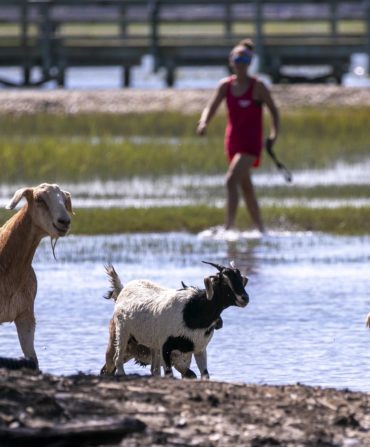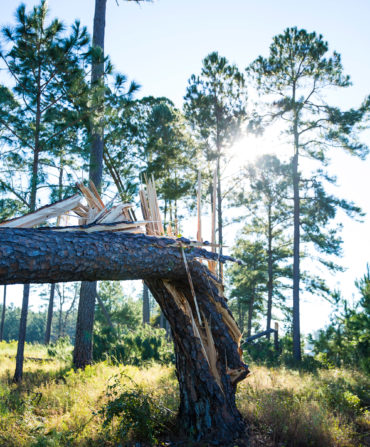Charged with delivering the annual Atlantic hurricane forecast to the nation and the world, the National Oceanic and Atmospheric Administration’s Climate Prediction Center is well-schooled in assessing our incoming natural disasters. This year, its forecasters posit a 60 percent chance of what they call an “above normal” hurricane season, which translates more specifically as thirteen to twenty named storms, six to ten of which will become hurricanes (defined as winds greater than seventy-four miles per hour). Of that select group of storms, we’re likely to see between three and five “major” hurricanes, classified on the Saffir-Simpson scale as having winds from 111 mph and up.
In 2020, an unprecedented eleven named storms of the season’s record-breaking thirty made landfall in the United States. Of those that hit North America, six were hurricanes. Last November’s Category 4 Hurricane Iota, which raked Central America with a maximum wind speed of 155 mph and ranked as the year’s strongest, gives us a graphic shot of that level of power.
To put that in perspective, Category 1 and 2 storms are simple hurricanes. Category 3, 4, and 5 storms are “major.” To wrap this year’s good news within this year’s bad news, although we do face yet another above-average year, we are not forecast to suffer a season on 2020’s gargantuan, history-making scale, one in which there were thirty named storms—so many that we literally ran out of names and delved deep into the Greek alphabet. More specifically, in 2020 there were seven major hurricanes, all of which hit the Americas, four of which hit the South. What the Climate Prediction Center’s experts are saying is that they think there will be from two to four fewer major hurricanes this season.
As ever, this admittedly small nugget of relief still means that there will be plenty of storms. There’s only a 10 percent chance of the season being below average, so at its virtual briefing in Washington in late May, the NOAA invited Federal Emergency Management director Deanne Criswell to tell everybody to drill down on preparations for an above-average season.
Any number of hurricanes is bad news any way we cut it, because most often, the South bears the brunt. But the real bad news is not in this most recent seasonal forecast. Rather, it’s in the adjustment that the NOAA was forced to make in its scale defining what an average hurricane season is.
That the metric itself has had to be revised significantly upward is key. The revision is based on a routine update of the unerringly accurate statistical averages. Previously—which is to say, until 2021—an average hurricane season was defined as twelve named storms, based on an average of the number of storms between the thirty years from 1981 to 2010. Now, the average is taken from the years 1991 to 2020, and the annual average of named storms in those years rings up at fourteen. The average annual count of major hurricanes remains at three.
Matt Rosencrans, the seasonal hurricane forecaster at the Climate Prediction Center who was a lead spokesman at the NOAA’s May 20 virtual press conference, explained the April updates to the seasonal average metric with the NOAA’s no-bones-about-it take on climate change: “These updated averages better reflect our collective experience of the past ten years,” he said, “which included some very active hurricane seasons. NOAA scientists have evaluated the impacts of climate change on tropical cyclones and determined that it can influence storm intensity.”
Climate change doesn’t necessarily influence the annual count of storms so much as it does their striking force, in other words. Schooled as all Southerners are in hurricanes, as we ready for a middling-to-high 2021 season, under Sun Tzu’s prescient tactical advice of “know thy enemy,” it behooves us to revisit how the storms come to be.
Atlantic tropical storms form in a kind of assembly line as the waves of moist low-pressure systems are blown by the easterly trade winds into the ocean off of the African continent. At that point, the meta-climatic forces—such as ocean warming (a strong generator of storm systems) and upper-atmosphere wind shear and Saharan dust (two great inhibitors of storms)—enter the play. If the upper atmosphere wind shear is weak, storms will form more readily. If the Saharan easterly is blowing a lot of dust over to the Caribbean—as is happening at this writing—then no matter how warm and inviting for budding storms the South Atlantic water is, the storms will have difficulty forming.
Essentially, when they make a seasonal forecast, what Rosencrans and his fellow forecasters at the NOAA are calculating are the probabilities of the next five months’ worth of behavior from those systems playing off each other, and on the feeder waves of warm, moist low pressure sauntering out in the ocean toward the South, the Caribbean and the Gulf of Mexico from the Central and West African monsoons, building up muscle before they pounce on us.
It’s the unending constancy of that process that the NOAA forecasters and trackers chronicle for us. In their performance, hurricanes are as intricately put together as symphonies; it’s an orchestra of forces they bring to bear on us: winds, tidal surge, precipitation, and satellite storms. Hurricane seasons being now as extraordinary as they are, the NOAA will update this early season forecast during the August peak, but the takeaway is, for the South, sadly unchanged: 2021 will be another tough year, so we might as well brace for it now.








